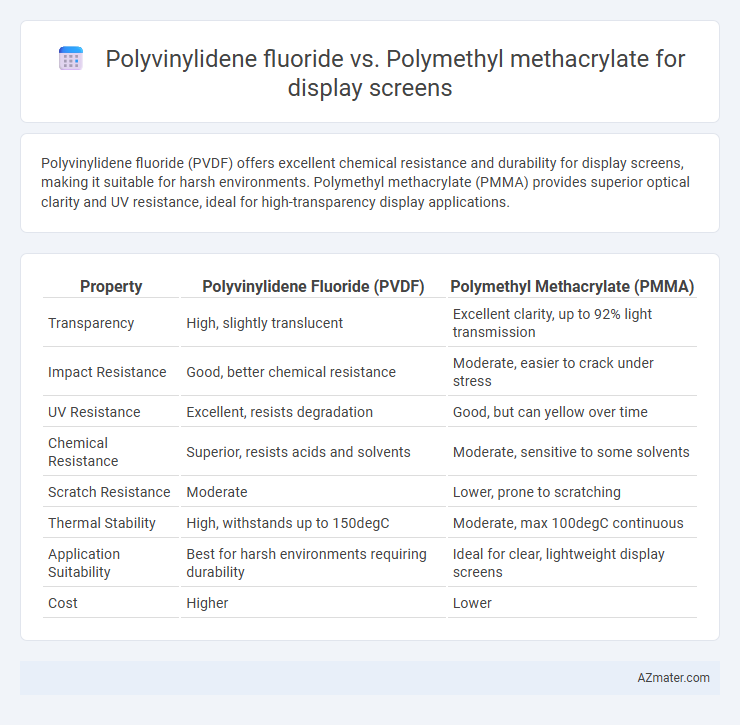Polyvinylidene fluoride (PVDF) offers excellent chemical resistance and durability for display screens, making it suitable for harsh environments. Polymethyl methacrylate (PMMA) provides superior optical clarity and UV resistance, ideal for high-transparency display applications.
Table of Comparison
| Property | Polyvinylidene Fluoride (PVDF) | Polymethyl Methacrylate (PMMA) |
|---|---|---|
| Transparency | High, slightly translucent | Excellent clarity, up to 92% light transmission |
| Impact Resistance | Good, better chemical resistance | Moderate, easier to crack under stress |
| UV Resistance | Excellent, resists degradation | Good, but can yellow over time |
| Chemical Resistance | Superior, resists acids and solvents | Moderate, sensitive to some solvents |
| Scratch Resistance | Moderate | Lower, prone to scratching |
| Thermal Stability | High, withstands up to 150degC | Moderate, max 100degC continuous |
| Application Suitability | Best for harsh environments requiring durability | Ideal for clear, lightweight display screens |
| Cost | Higher | Lower |
Introduction to Display Screen Materials
Polyvinylidene fluoride (PVDF) and polymethyl methacrylate (PMMA) are prominent materials used in display screens, each offering unique properties for visual performance and durability. PVDF excels in chemical resistance, thermal stability, and mechanical strength, making it suitable for touch-sensitive and flexible display applications. PMMA, known for its excellent optical clarity, light weight, and ease of fabrication, is preferred in rigid display panels and protective screen covers.
Overview of Polyvinylidene Fluoride (PVDF)
Polyvinylidene fluoride (PVDF) is a high-performance fluoropolymer known for its excellent chemical resistance, mechanical strength, and durability in display screen applications. PVDF offers superior UV stability and thermal resistance compared to polymethyl methacrylate (PMMA), making it ideal for outdoor and harsh environment displays. Its low surface energy and strong adhesion properties enable robust protective coatings and flexible display components.
Overview of Polymethyl Methacrylate (PMMA)
Polymethyl methacrylate (PMMA) is a transparent thermoplastic commonly used as a lightweight and shatter-resistant alternative to glass in display screens. It features excellent optical clarity with high light transmittance of approximately 92%, making it ideal for enhancing screen brightness and visibility. PMMA also offers good weather resistance and durability, though it is less chemically resistant and less flexible compared to polyvinylidene fluoride (PVDF).
Optical Clarity and Transparency Comparison
Polyvinylidene fluoride (PVDF) exhibits moderate optical clarity with slight opacity, making it less transparent compared to polymethyl methacrylate (PMMA), which offers exceptional transparency and high light transmittance above 90%. PVDF's inherent semi-crystalline structure scatters light to some degree, reducing its suitability for applications demanding pristine clarity in display screens. PMMA's amorphous polymer matrix provides superior optical clarity and low haze, ideal for high-definition displays requiring maximum visual performance.
Mechanical Strength and Durability
Polyvinylidene fluoride (PVDF) offers superior mechanical strength and durability compared to polymethyl methacrylate (PMMA), making it more resistant to impact and environmental stress on display screens. PVDF's high tensile strength and excellent chemical resistance enable it to withstand prolonged exposure to UV radiation and temperature fluctuations without degrading. PMMA, while providing excellent optical clarity, is more prone to scratching and lower impact resistance, which limits its long-term durability in high-stress display applications.
Chemical Resistance and Environmental Stability
Polyvinylidene fluoride (PVDF) exhibits superior chemical resistance and environmental stability compared to polymethyl methacrylate (PMMA), making it ideal for display screens exposed to harsh conditions. PVDF resists solvents, acids, and UV radiation significantly better, ensuring long-term durability and preventing degradation. In contrast, PMMA is more prone to chemical attack and UV-induced yellowing, limiting its lifespan in outdoor or chemically aggressive environments.
Flexibility and Formability for Screen Design
Polyvinylidene fluoride (PVDF) offers superior flexibility and formability compared to Polymethyl methacrylate (PMMA), making it ideal for curved and flexible display screen designs. PVDF's excellent mechanical resilience allows it to withstand repeated bending and shaping without cracking, supporting innovative screen architectures. In contrast, PMMA provides rigidity and clarity but lacks the elasticity needed for advanced flexible displays, limiting its application to flat, rigid screens.
Surface Treatments and Coating Compatibility
Polyvinylidene fluoride (PVDF) exhibits superior chemical resistance and UV stability, making it highly suitable for durable display screen surface treatments, whereas polymethyl methacrylate (PMMA) offers excellent optical clarity but lower resistance to harsh chemicals and UV exposure. PVDF surfaces benefit from advanced fluoropolymer coatings that enhance abrasion resistance and maintain hydrophobic properties, while PMMA requires specialized anti-scratch coatings to prevent surface degradation and yellowing. Coating compatibility on PVDF often involves plasma treatment to improve adhesion, whereas PMMA's surface treatments typically include UV-curable coatings designed to preserve transparency and reduce surface wear.
Cost and Manufacturing Considerations
Polyvinylidene fluoride (PVDF) offers superior chemical resistance and durability for display screens but comes at a higher material and processing cost compared to polymethyl methacrylate (PMMA). PMMA is favored for its lower manufacturing expenses, ease of fabrication, and optical clarity, making it cost-effective for large-scale production despite less chemical stability. Manufacturing considerations include PVDF's need for specialized equipment and controlled processing conditions while PMMA benefits from well-established thermoforming and extrusion techniques.
Applications and Suitability in Display Technology
Polyvinylidene fluoride (PVDF) offers superior chemical resistance and excellent dielectric properties, making it highly suitable for flexible display screens and touch-sensitive interfaces in harsh environments. Polymethyl methacrylate (PMMA) provides exceptional optical clarity and UV resistance, ideal for rigid display panels and protective screen covers where transparency and impact resistance are critical. In display technology, PVDF is preferred for applications requiring durability and flexibility, whereas PMMA excels in optical performance and surface hardness.

Infographic: Polyvinylidene fluoride vs Polymethyl methacrylate for Display Screen
 azmater.com
azmater.com